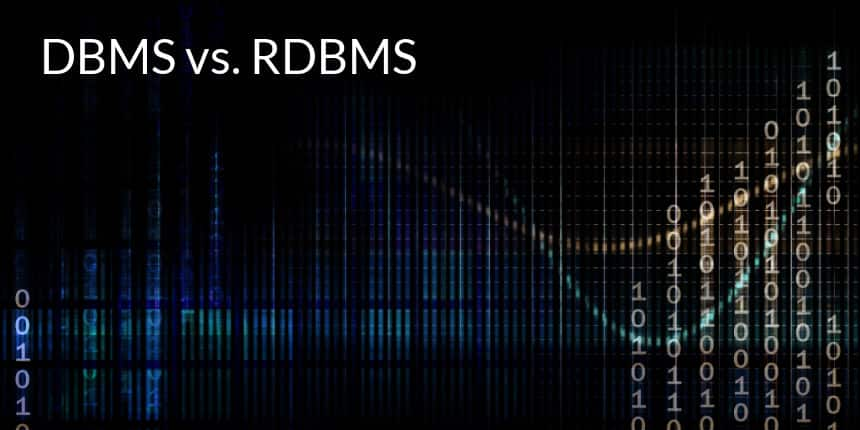Manav Rachna University | B.Sc Admissions 2025
Admissions open for B.Sc. (Hons.)- Chemistry, Mathematics, Physics & more
In the early days of computer technology, the information that was produced had to be stored and organised on cassettes, a method that is now largely obsolete. As a result of the necessity to address this problem, a database was created. The one significant drawback of employing the tape-based storage option was the data's inability to be reread. Since that time, databases have established themselves as an essential tool for all requirements linked to data storage. One can learn database management in some of the popular DBMS certification courses.

The technologies used to store data and use databases for data storage are the foundation of the DBMS (Database Management System) and RDBMS (Relational Database Management System) systems; the apparent difference between database and RDBMS. Simply said, a database is a collection of data that both of them are responsible for managing. A database uses a structured format to store its data. The database can be helpful in maintaining, storing, and retrieving the data when necessary thanks to this layer that structures the data.
The demand for a reliable method of managing databases likewise increased as databases and their use rose. Consequently, both DBMS and RDBMS technologies entered the picture. Finding the difference between DBMS and RDBMS could be challenging for someone new to this field because both DBMS and RDBMS differences seem quite similar. However, we first need to take a closer look at both of these database management systems in order to completely understand the level of differences between database and RDBMS.
The DBMS, or database management system, is a piece of software made specifically for handling and storing data. It was first introduced in the 1960s and includes a full range of tools for manipulating data, including the ability to delete, insert, and update data in databases. The database must be created, improved, defined, and controlled by the DBMS. Businesses and people may now closely interact with databases and obtain the information they need thanks to DBMS technology.
To the already-existing database management technology, RDMBS adds the R of relational. RDBMS, which was developed in the 1970s, was intended to be a more complex iteration of DBMS. RDBMS also offers a level of sophistication for the company or the people accessing the data kept in the database.
The fact that RDBMS can only store data in tabular form is one of its fundamental characteristics. Rows and columns are used to store and sort data in RDBMS (also called tuples and attributes in the DBMS language). RDBMS unquestionably has greater power than the standard DMBS, which is why it has gained widespread acceptance.
Ranked #46 Among Universities in India by NIRF | 1950+ Students Placed 91% Placement, 590+ Recruiters | Last Date to Apply: 30th July | Limited seats available in select program
NAAC A+ Accredited| Ranked #24 in University Category by NIRF | Applications open for multiple UG & PG Programs
Now that we are familiar with the definitions of both RDBMS and DBMS, we can talk about DBMS and RDBMS differences. To start, the following are some of the RDBMS and DBMS differences:
While information is kept in tables by RDBMS, it is kept in files by DBMS.
RDBMS allows for numerous users, whereas DBMS can only be utilised by one person.
RDBMS is the only database management system that supports client-server side interaction and architecture; DBMS does not.
In contrast to RDMBS, DBMS has fewer hardware and software requirements. You would need a more powerful machine to run RDMBS correctly.
Redundant data can exist in DBMS. This means that while utilising a DBMS, data can be repeated. The indexing in RDBMS, however, prevents us from having redundant data.
RDBMS | DBMS |
The data stored is in table format | The data stored is in the file format |
Multiple data elements are accessible together | Individual access to data elements |
Data in the form of a table are linked together | No connection between the data |
Normalisation is not achievable | There is normalisation |
Support distributed database | No support for distributed database |
Data is stored in a large amount | The data stored is a small quantity |
Here, the redundancy of data is reduced with the help of keys and indexes in RDBMS | Data redundancy is common |
RDBMS supports multiple users | DBMS supports a single-user |
It features multiple layers of security while handling data | There is only low security while handling data |
The software and hardware requirements are higher | The software and hardware requirements are low |
Oracle, SQL Server. | XML, Microsoft Access. |
The above table describing DBMS vs RDBMS pointers shall make a lot of confusion around the question "What is the difference between DBMS and RDBMS?" clear to understand and grasp. Many database specialists have found themselves torn between the pros and cons of RDBMS vs DBMS from time to time. Hopefully, this article was able to shed some light on the DBMS RDBMS difference debate.
Ranked amongst top 3% universities globally (QS Rankings)
Ranked amongst top 3% universities globally (QS Rankings)
NAAC A+ Grade | Among top 100 universities of India (NIRF 2024) | 40 crore+ scholarships distributed
Campuses in Ropar, Agartala, Aizawl, Ajmer, Aurangabad, Calicut, Imphal, Itanagar, Kohima, Gorakhpur, Patna & Srinagar
Ranked amongst top 3% universities globally (QS Rankings)
Ranked #46 amongst Universities in India by NIRF | 1900+ Students Placed | 94% Placement | 633+ Recruiters | Last Date to Apply: 30th July | Limited seats available in select program